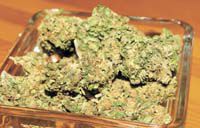| Over one ounce of high grade marijuana. Prices for the debated “gateway” substance run from $25 to $60 per one eighth of an ounce. |
The debate regarding marijuana’s position as the foremost gateway substance in the war on drugs continues to rage.
One camp of scientific researchers maintain marijuana is the beginning of the end for substance abusers.
In the opposing camp, the experts contend that marijuana’s title as the gateway drug is ludicrous.
A section from Gateway Theory, a publication released by the federal war on drugs task force, states:
“The gateway hypothesis holds that abusable drugs occupy distinct ranks in a hierarchy as well as definite positions in a temporal sequence.
“When illicit drug use occurs first, it is very likely due to the opportunity afforded by the neighborhood environment in context of low parental supervision.”
Local Four Corners Behavioral Health substance abuse counselor Kaylum Paletta demonstrated a similar sentiment when it came to marijuana’s place as the gateway drug.
“If you take alcohol out of the equation, which I don’t think you should do, I have noticed that approximately 85 percent to 90 percent of my clients used marijuana first among illegal drugs,” indicated Paletta. “And I do feel that marijuana leads to heavier drug use – not because of its psychotropic affects, but because of the environment it places the user in.”
“It is the drug seeking behavior and the unhealthy environment the drug places an individual in that introduces them to other drugs,” pointed out the substance abuse counselor.
“I am not saying that marijuana does not have dangers unto itself. What I am saying is, that as far as the Gateway Theory goes, it is the environment that makes pot dangerous to youth,” noted Paletta.
Many researchers and experts within the scientific community feel differently about marijuana.
“Marijuana is not a gateway drug that predicts or eventually leads to substance abuse,” suggests a 12-year University of Pittsburgh study, according to a Science Daily report.
“Moreover, the study’s findings call into question the long held belief that has shaped prevention efforts and governmental policy for six decades and caused many a parent to panic upon discovering a bag of pot in their child’s bedroom,” noted the University of Pittsburgh researchers
The study reported that 214 boys were tracked from the ages of 10 to 12 years old.
When the boys in the study reached the age of 22, they were separated into three groups.
The groups of 22-year-olds included the boys:
•Who used only alcohol or tobacco.
•Who used alcohol and tobacco, then marijuana (gateway sequence).
•Who used marijuana prior to alcohol and tobacco (reverse sequence).
The study found that the reverse pattern users were more likely to have lived in poor physical neighborhood environments.
The reverse pattern users also had more exposure to drugs in their neighborhoods and less parental involvement as young children.
The university study also demonstrated that the boys who exhibited the reverse pattern to a greater extent were almost twice as likely to have serious problems with drug addiction later in life.
The study subjects exhibiting the reverse pattern to a greater extent had tried different illicit drugs before using marijuana.
Since marijuana use typically precedes rather than follows the initiation of other illicit drugs, the United States Institute of Medicine contends that it is a gateway drug.
But because underage smoking and alcohol consumption typically precede marijuana use, the illicit drug is not the most common and is rarely the first gateway to unlawful behavior.
The Four Corners substance abuse counselor has developed a definite opinion regarding the matter.
“I think tobacco, alcohol and pot all get overlooked to a certain extent by authorities and parents alike. They are all worried that their kids are going to get hooked on meth and, as long as they are not doing meth or other hard drugs, they are fine.,” said Paletta. “This is not the truth of the situation.”
“Tobacco, alcohol and pot need to be the front line in a parent’s fight against their child’s potential drug abuse,” stressed Paletta.
Some studies on marijuana as a gateway substance have resulted in no better answer to the debated than maybe.
The National Institute on Substance Abuse recently compiled data and released a question and answer document on marijuana.
The substance abuse institute’s public educational document included the question:
Does marijuana lead to the use of other drugs?
The answer indicated:
“It could. Long term studies of high school students and their patterns of drug use show that very few young people use other illegal drugs without first trying marijuana. To better determine the risk, scientist are currently examining the possibility that long term use may create changes in the brain that make a person more at risk of becoming addicted to other drugs, such as alcohol or cocaine.
The experts for and against the marijuana gateway theory appear to agree on one area. Young people’s behavior and environment have the strongest influence on whether they will have problems with drug abuse later in life.
The Science Daily report indicated that “the emphasis on the drugs themselves, rather than other more important factors that shape a person’s behavior, has been detrimental to the drug policy and prevention programs from the beginning.”
Local drug abuse treatment personnel share the same sentiments.
“If you want to help your kids, then take the time to check out their friends and their friends’s parents,” advised Paletta. “Make sure your kids are in a healthy environment. If you see a change in their behavior, don’t just let it slide, find out what is going on.”
Editors note: Today’s article is the first of a three part series about the ongoing marijuana gateway drug debate.

